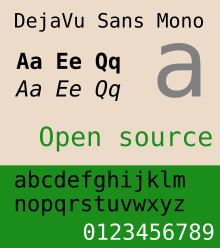DejaVu fonts
| Category | Serif, Sans (sans-serif), Sans Mono (monospace) variants: Bold, Oblique, Bold Oblique |
|---|---|
| Foundry | None |
| Date created | 2004 |
| Date released | 2011-02-27 v.2.33 |
| License | Free license |
| Design based on | Bitstream Vera release 1.10 |
| Variations | Serif Condensed (*), Sans Condensed (*), (*): experimental style |
 | |
| Sample | |
| Website | [1] |
The DejaVu fonts are modifications of the Bitstream Vera fonts designed for greater coverage of Unicode, as well as providing more styles. The Bitstream Vera family was limited mainly to the characters in the Basic Latin and Latin-1 Supplement portions of Unicode (roughly equivalent to ISO-8859-15) but was released with a license that permitted changes. The DejaVu fonts project was started with the aim to "provide a wider range of characters... while maintaining the original look and feel through the process of collaborative development". The development of the fonts is done by many contributors, and is organized through a wiki and a mailing list.
The DejaVu fonts project was started by Štěpán Roh. Over time, it has absorbed several other projects that also existed to extend the Bitstream Vera typefaces; these projects include the Olwen Font Family, Bepa, Arev Fonts (only partially), and the SuSE standard fonts. The fonts are free software, and may thus freely be embedded. DejaVu fonts can be obtained from the DejaVu project on SourceForge. Some GNU/Linux distributions (such as Ubuntu, OpenSUSE and Mandriva Linux) include DejaVu fonts in their default installation.[1][2][3] The open source software OpenOffice.org includes DejaVu fonts in its installation packages.[4][5][6] These fonts are also included in proprietary BlackBerry OS (under the name BBAlphaSans and BBAlphaSerif).[7]



Role of typographically-incompatible scripts
Recently there has been some question within the DejaVu community about the role of scripts typographically incompatible with the typographically-similar scripts Latin, Greek, and Cyrillic (LGC). Most notably, Arabic has been added, but it has caused some software compatibility issues. Further, Latin and Arabic scripts have fundamentally different approaches to typefaces: while Latin fonts have serif and sans-serif versions, Arabic fonts have different distinctions (see Islamic calligraphy). It is still uncertain how the project should handle the mixture between different Latin faces and the different Arabic faces.
The uncertain status of Arabic and other alphabets has led to the creation of DejaVu LGC, a subset of the DejaVu fonts which contains only Latin, Greek, and Cyrillic characters. This version also tends not to experience as many software issues.[citation needed]
Coverage
DejaVu is an active project, which aims for complete coverage of the alphabetic scripts, abjads, and symbols with all characters that are part of the MES-1, MES-2, and hopefully MES-3 subsets of Unicode. The coverage is already considerable, although some more work is needed to include more hinting rules for clear results at small sizes. Some kerning rules are still being developed for the Sans and Serif styles, for fine typography. Some work is still also needed to create ligatures in these styles.
As of version 2.32, it included characters from the following Unicode blocks.[8] (The fraction given is the number of characters in each block that are included in the DejaVu fonts.)
Styles
The 10 styles provided by the original Bitstream Vera fonts have been augmented to 21 styles:
| DejaVu Sans | DejaVu Serif | DejaVu Sans Mono |
|---|---|---|
| Book / Oblique | Book / Italic | Book / Oblique |
| Bold / Oblique | Bold / Italic | Bold / Oblique |
| Extralight | ||
| Condensed / Oblique | Condensed / Italic | |
| Condensed Bold / Oblique | Condensed Bold / Italic |
Original styles are marked in bold.
See also
References
- ^ "DejaVu - Download". Retrieved 2010-02-05.
- ^ "Package List/11.2/KDE4-LiveCD-i686". Retrieved 2010-02-05. [dead link]
- ^ Packages included in Mandriva Linux One 2010, retrieved 2010-02-05
- ^ "New Features in OpenOffice.org 2.4". 2008-03. Retrieved 2010-01-15.
{{cite web}}: Check date values in:|date=(help) - ^ "OpenOffice.org Wiki - External/Modules". Retrieved 2010-01-31.
- ^ "Debian - Package: openoffice.org". Retrieved 2010-01-31.
- ^ "Like Those Pretty Fonts in OS 4.5+? Thank Bitstream (Bolt) & DejaVu". 2009-08-07.
- ^ "DejaVu unicode coverage file". Retrieved 2010-08-23.
External links
- DejaVuWiki (official website)
- http://sourceforge.net/projects/dejavu/ (Sourceforge project website)
- CNet article on DejaVu fonts, July 11, 2006
